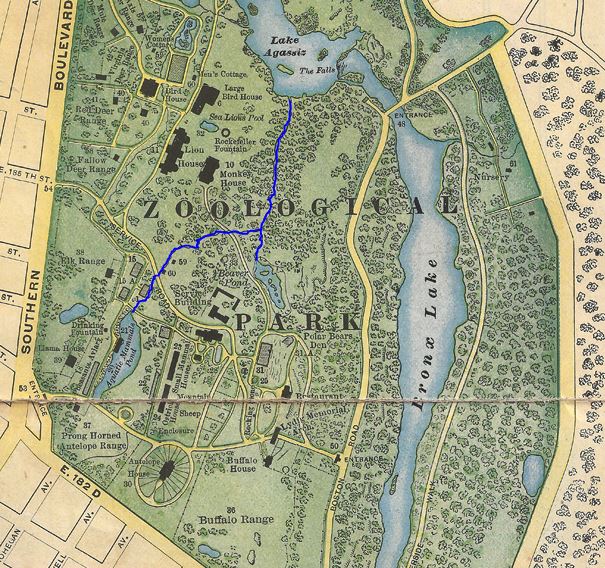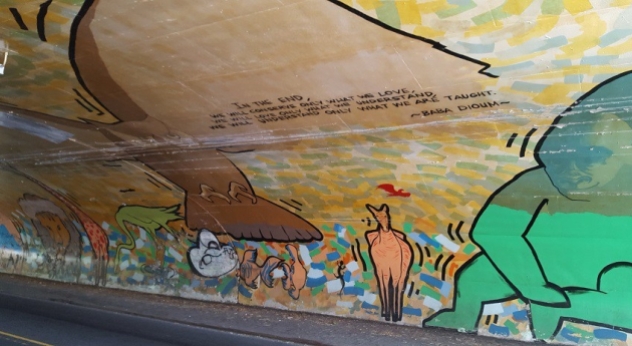In its course within the Bronx Zoo, the Bronx River contains plenty of Hidden Waters materials such as a long-forgotten boathouse, a tributary stream, and a lake that flows into the river. At the Bronx River Gate to the zoo on Boston Road there is a walkway along its shore with a view of a waterfall that is open to the public free of charge.

It is a scenic and quiet corner of the otherwise heavily visited zoo, its centerpiece being a 10-foot cascade that appears as a waterfall.
Where it flows

Looking at the 1904 New York Central brochure depicting the zoo, the waterfall is marked as The Falls, separating the Lake Agassiz and Bronx Lake sections of the Bronx River. At the time, the ancient Boston Road ran through the zoo grounds as it had for centuries. On the eastern bank of the river, Bronx River Parkway was not yet built. It will arrive in 1951.

The bridge carrying Boston Road across Bronx River is nearly a century old. Traveling through the zoo it has the same appearance as when it was a vital postal route between Boston and New York in the colonial period. To the north of Bronx Zoo, Boston Road is marked as U. S. Route 1, a longer series of connected roads running from Fort Kent, Maine down to Key West. The road became part of the zoo in 1924 and closed to outside traffic shortly afterward.

I’m a big supporter of signs, the more the better to explain where one is standing. On the Boston Road bridge is a sign directing visitors to the Mitsubishi Riverwalk and the wildlife that can be found in this section of the zoo.
Underpass Mural
Boston Road’s underpass beneath the Bronx River Parkway serves as an eastern gateway into the zoo and fortunately it has a wildlife-themed mural serving as a reminder to travelers that the entrance is only a thousand feet beyond this bridge. Signs for Mitsubishi Riverwalk are not as visible. To enter this area, a trail breaks off to the right past the parking lot tollbooths. I am a strong supporter of painting murals anywhere and everywhere. No place is more deserving of beautification than a highway underpass.
The quote by Baba Dioum is also fitting as the Bronx has New York’s largest African immigrant population. Dioum is Senegalese, renowned for his work in forestry, water management and agriculture.
On the Riverwalk

The Mitsubishi Riverwalk opened to the public on April 15, 2004 serving as an example by the Wildlife Conservation Society and Mitsubishi that their global efforts to restore streams also include a local example in the Bronx. At this site the work included the removal of invasive plant species, reintroduction of native plants, removal of trash, restoration of walking paths, and installation of educational signs. The Parks Department also contributes towards the stream’s restoration by reintroducing native fish to it.
Although one may think of a riverwalk as a path touching the water’s edge, this one runs atop a ridge overlooking the twin falls on the Bronx River.
The sign above depicts the environmental impact of dams on water temperature and wildlife. for all the talk about restoring the Bronx river to its natural state, there are no plans to remove any of the dams on its course. While the twin cascade behind this sign is picturesque, the trees blocking the view are allowed to grow in place.
Bolton Dam

In fact there are no natural waterfalls within New York City. All of them were either constructed as part of a park’s landscape or were built as milldams. That’s the case with Bronx River Falls, built in 1848 as Bolton Dam. That year property owner Henry B. Bolton dammed the river and used its water for his Bronx Bleachery company, which dyed fabrics, sending the runoff directly into the river. The company was a major employer for the neighboring Bronxdale neighborhood, and may of its workers followed the company’s example by depositing their trash and bodily waste into the river.
Bronx River historian Maarten de Kaadt counts twelve dams along the river’s course, four of them within the Bronx, two of them within the zoo. In 1888, the city acquired the factory and dam by eminent domain as part of Bronx Park.
The dam looks almost as natural as a waterfall with no trace of the industrial revolution that built it. While the 182nd Street Dam further downstream has a recently-constructed “fish ladder” this dam does not yet have one.
Wildlife

One pleasant aspect of this riverwalk is the wildlife. In any other park, brown squirrels and pigeons are everywhere to be seen. Here, one can see chipmunks and squirrels of other hues.
Postcard Bridge

I found online an untitled postcard from 1905 depicting a bridge across the Bronx River. My initial guess is that it shows Boston Road, the oldest road to cross this stream, but perhaps this is 180th Street which also has a dam close to it. If any readers have details on this bridge, please leave a comment.
Learn More:
Bronx Zoo also has Cope Lake, which I previously documented, and Northern Ponds, both of which drain into the Bronx River.
Prior to 1960, the zoo had its own boathouse that stood on the site of today’s JungleWorld exhibit.
The rich history of the Wildlife Conservation Society and Bronx Zoo is told in great detail at Wild Things: The WCS Archives Blog.



Thank you for this post! I live nearby and had no idea the waterfall was there. I just wanted to leave a note to say the beautiful Baba Dioum mural in the underpass is very sadly no longer there. The surface of the walls were deteriorating and peeling (as you can see the ceiling beginning to do in your photos) and after a couple years of it looking pretty bad, they did some repair and painted over the mural with a flat boring gray. Very sad indeed. But I wanted to leave a note to let anyone hoping to use the mural as a landmark on their way to the riverwalk know that they will not find it.
LikeLike